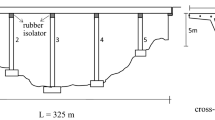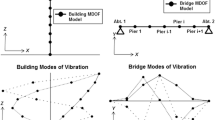Abstract
The increasing awareness of the general society toward the seismic safety of structures has led to more restrictive performance requirements hence, many times, to the need of using new and more accurate methods of analysis of structures. Among these, nonlinear static procedures are becoming, evermore, the preferred choice of the majority of design codes, as an alternative to complete nonlinear time-history analysis for seismic design and assessment of structures. The many available software tools should therefore be evaluated and well understood, in order to be easily and soundly employed by the practitioners. The study presented herein intends to contribute to this need by providing further insight with respect to the use of commonly employed structural analysis software tools in nonlinear analysis of bridge structures. A comparison between different nonlinear modeling assumptions is presented, together with the comparison with real experimental results. Furthermore, alternative adaptive pushover procedures are proposed and applied to a case study bridge, based on a generic plastic hinge model. The adopted structural analysis program proved to be accurate, yielding reliable estimates, both in terms of local plastic hinge behavior and global structural behavior.
Similar content being viewed by others
References
Miranda E, Bertero V V. Evaluation of strength reduction factors. Earthquake Spectra, 1994, 10(2): 357–379
CEB. Seismic design of RC structures for controlled inelastic response. Bulletin no. 236, Comité Euro-International du Béton, 1997
Kappos A J. Evaluation of behaviour factors on the basis of ductility and overstrength studies. Engineering Structures, 1999, 21(9): 823–835
Mwafy AM, Elnashai A S. Calibration of force reduction factors for RC buildings. Journal of Earthquake Engineering, 2002, 6(2): 239–273
Maheri M R, Akbari R. Seismic behaviour factor, R, for steel Xbraced and knee braced RC buildings. Engineering Structures, 2003, 25(12): 1505–1513
Costa A, Romão X, Oliveira C S. A methodology for the probabilistic assessment of behaviour factors. Bulletin of Earthquake Engineering, 2010, 8(1): 47–64
Paret T, Searer G, Freeman S. ASCE 31 and 41: Apocalypse Now. Structures Congress, Las Vegas, Nevada, 2011
Araújo M, Castro J. Critical review of codes for seismic safety assessment of existing steel buildings. Journal of Earthquake Engineering, 2016 (in Press)
Johnson N, Saiidi M, Sanders D. Nonlinear earthquake response modelling of a large-scale two-span concrete bridge. Journal of Bridge Engineering, 2009, 14(6): 460–471
Inel M, Ozmen H B. Effects of plastic hinge properties in nonlinear analysis of reinforced concrete buildings. Engineering Structures, 2006, 28(11): 1494–1502
Habibullah A, Pyle S. Practical three dimensional nonlinear static pushover analysis. Structures Magazine, winter, 1998
Varum H, Sousa R, Delgado W, Fernandes C, Costa A, Jara J M, Jara M, Álvarez J J. Comparative structural response of two steel bridges constructed 100 years apart. Structure and Infrastructure Engineering, 2011, 7(11): 843–855
Araújo M, Delgado R. Seismic safety assessment of curved bridges using pushover analysis. Papadrakakis M, Papadopoulos V, Plevris V, eds. 3rd ECCOMAS Thematic Conference on Computational Methods in Structural Dynamics and Earthquake Engineering (COMPDYN 2011), Corfu, Greece, 25–28 May, 2011
Araújo M, Marques M, Delgado R. Multidirectional pushover analysis for seismic assessment of irregular-in-plan bridges. Engineering Structures, 2014, 79: 375–389
Rodrigues H, Varum H, Arêde A, Costa A. Comparative efficiency analysis of different nonlinear modelling strategies to simulate the biaxial response of RC columns. Earthquake Engineering and Engineering Vibration, 2012, 11(4): 553–566
Casarotti C, Monteiro R, Pinho R. Verification of spectral reduction factors for seismic assessment of bridges. Bulletin of New Zealand Society for Earthquake Engineering, 2009, 42: 111–121
Pinho R, Monteiro R, Casarotti C, Delgado R. Assessment of continuous span bridges through nonlinear static procedures. Earthquake Spectra, 2009, 25(1): 143–159
Kohrangi M, Bento R, Lopes M. Seismic performance of irregular bridges–comparison of different nonlinear static procedures. Structure and Infrastructure Engineering, 2015, 11(12): 1642–1650
Monteiro R, Delgado R, Pinho R. Probabilistic seismic assessment of RC bridges: Part I–uncertainty models. Structures, 2016a, 5: 258–273
Monteiro R, Delgado R, Pinho R. Probabilistic seismic assessment of RC bridges: Part II–nonlinear demand prediction. Structures, 2016, 5: 274–283
CSI. CSI Analysis Reference Manual for SAP2000. ETABS and SAFE, Computer and Structures, Inc, California, 2010
Pinho R, Casarotti C, Antoniou S. A comparison of single-run pushover analysis techniques for assessment of bridges. Earthquake Engineering & Structural Dynamics, 2007, 36(10): 1347–1362
Kunnath S. Identification of modal combination for nonlinear static analysis of building structures. Computer-Aided Civil and Infrastructure Engineering, 2004, 19(4): 264–259
Krawinkler H, Seneviratna G. Pros and cons of a pushover analysis of seismic performance evaluation. Engineering Structures, 1998, 20(4-6): 452–464
Elnashai A S. Advanced inelastic static (pushover) analysis for earthquake applications. Structural Engineering and Mechanics, 2001, 12(1): 51–69
Paret T, Sasaki K, Eilbeck D, Freeman S. Approximate inelastic procedures to identify failure mechanisms from higher mode effects. In: Proceedings of the 11th World Conference on Earthquake Engineering. Acapulco, 1996
Chopra A, Goel R. A modal pushover analysis procedure for estimating seismic demands for buildings. Earthquake Engineering & Structural Dynamics, 2002, 31(3): 561–582
Bracci J, Kunnath S, Reinhorn A. Seismic performance and retrofit evaluation of reinforced concrete structures. Journal of Structural Engineering, 1997, 123(1): 3–10
Requena M, Ayala A G. Evaluation of a simplified method for the determination of the nonlinear seismic response of RC frames. In: Proceedings of the 12th World Conference on Earthquake Engineering. Auckland, 2000
Paraskeva T S, Kappos A J, Sextos A G. Extension of modal pushover analysis to seismic assessment of bridges. Earthquake Engineering & Structural Dynamics, 2006, 35(10): 1269–1293
Antoniou S, Pinho R. Development and verification of a displacement- based adaptive pushover procedure. Journal of Earthquake Engineering, 2004, 8(5): 643–661
Pinho R, Marques M, Monteiro R, Casarotti C, Delgado R. Evaluation of nonlinear static procedures in the assessment of building frames. Earthquake Spectra, 2013, 29(4): 1459–1476
Monteiro R, Marques M, Adhikari G, Casarotti C, Pinho R. Spectral reduction factors evaluation for seismic assessment of frame buildings. Engineering Structures, 2014, 77: 129–142
Casarotti C, Pinho R. An Adaptive Capacity Spectrum Method for assessment of bridges subjected to earthquake action. Bulletin of Earthquake Engineering, 2007, 5(3): 377–390
Zelaschi C, De Angelis G, Giardi F, Forcellini D, Monteiro R. Performance based earthquake engineering approach applied to bridges in a road network. Papadrakakis M, Papadopoulos V, Plevris V, eds. 5th ECCOMAS Thematic Conference on Computational Methods in Structural Dynamics and Earthquake Engineering (COMPDYN 2015), Crete Island, Greece, 25–27 May, 2015
Taucer F, Spacone E, Filippou F. A fiber beam-column element for seismic response analysis of reinforced concrete structures. Report UCB/EER-91/17, Earthquake Engineering Research Center, University of California, California, 1991
CEN. EN 1998–2: 2005 Eurocode 8: Design of Structures for Earthquake Resistance–Part 2: Bridges. European Committee for Standardization, Brussels, 2005
ATC. ATC-40 Seismic evaluation and retrofit of concrete buildings. Volume 1, Applied Technology Council, California, 1996
ASCE. Seismic evaluation and retrofit of existing buildings (ASCE/SEI 41–13). American Society of Civil Engineers, Virginia, 2014
CALTRANS. Caltrans Seismic design criteria. Version 1. 6, California Department of Transportation, California, 2010
Aviram A, Mackie K, Stojadinović B. Guidelines for nonlinear analysis of bridge structures in California, PEER Report 2008/03, Pacific Earthquake Engineering Research Center, University of California, California, 2008
Bae S, Bayrak O. Plastic hinge length of reinforced concrete columns. ACI Structural Journal, 2008, 290–300
Dowell R K, Seible F, Wilson E. Pivot hysteresis model for reinforced concrete members. ACI Structural Journal, 1998, 607–617
Park R, Paulay T. Reinforced concrete structures. New York: John Wiley and Sons, 1975
Mander J B, Priestley M J N, Park M. Theoretical stress-strain model for confined concrete. Journal of Structural Engineering, 1988, 114(8): 1804–1826
Rodrigues H, Arêde A, Varum H, Costa A. Experimental evaluation of rectangular reinforced concrete column behaviour under biaxial cyclic loading. Earthquake Engineering & Structural Dynamics, 2013, 42(2): 239–259
Rodrigues H, Arêde A, Varum H, Costa A. Damage evolution in reinforced concrete columns subjected to biaxial loading. Bulletin of Earthquake Engineering, 2013, 11(5): 1517–1540
CEN. EN 1998–1: 2004 Eurocode 8: Design of Structures for Earthquake Resistance–Part 1: General rules, seismic action and rules for buildings. European Committee for Standardization, Brussels, 2004
Monteiro R, Ribeiro R, Marques M, Delgado R, Costa A G. Pushover Analysis of RC Bridges Using Fibre Models or Plastic Hinges. In: Proceedings of the 14th World Conference on Earthquake Engineering. Beijing, China October12–17, 2008
Monteiro R. Sampling based numerical seismic assessment of continuous span RC bridges. Engineering Structures, 2016, 118: 407–420
Chaboche J L. A review of some plasticity and viscoelastic constitutive theories. International Journal of Plasticity, 2008, 24 (10): 1642–1693
Ibarra L F, Medina R A, Krawinkler H. Hysteretic models that incorporate strength and stiffness deterioration. Earthquake Engineering & Structural Dynamics, 2005, 34(12): 1489–1511
Orakcal K, Wallave JW, Conte J P. Flexural modelling of reinforced concrete walls–model attributes. ACI Structural Journal, 2004, 688–698
Billah A M, Alam M S. Seismic performance of concrete columns reinforced with hybrid shape memory alloy (SMA) and fiber reinforced polymer (FRP) bars. Construction & Building Materials, 2012, 28(1): 730–742
Guedes J M. Seismic behaviour of reinforced concrete bridges. Modelling, numerical analysis and experimental assessment. Dissertation for the Doctoral Degree. University of Porto, Porto, 1997
Araújo M, Macedo L, Marques M, Castro J M. Code-based record selection methods for seismic performance assessment of buildings. Earthquake Engineering & Structural Dynamics, 2016, 45(1): 129–148
Paraskeva T, Kappos A. Further development of a multimodal pushover analysis procedure for seismic assessment of bridges. Earthquake Engineering & Structural Dynamics, 2010, 39: 211–222
Isaković T, Lazaro M, Fishinger M. Extension of pushover methods for the seismic analysis of single-column bent viaducts. Earthquake Engineering & Structural Dynamics, 2008, 37(8): 1185–1202
Araújo M, Delgado R. Application of adaptive pushover methods of analysis to SAP2000. In: Proceedings of the Congress in Numerical Methods in Engineering, Coimbra, 2011
Acknowledgements
This work was supported by the Foundation of Science and Technology (FCT) of Portugal under Grant number PTDC/ECM-EST/3062/2012 “Earthquake loss assessment of the Portuguese building stock”.
Author information
Authors and Affiliations
Corresponding author
Rights and permissions
About this article
Cite this article
Monteiro, R., Araújo, M., Delgado, R. et al. Modeling considerations in seismic assessment of RC bridges using state-of-practice structural analysis software tools. Front. Struct. Civ. Eng. 12, 109–124 (2018). https://doi.org/10.1007/s11709-017-0389-7
Received:
Accepted:
Published:
Issue Date:
DOI: https://doi.org/10.1007/s11709-017-0389-7




